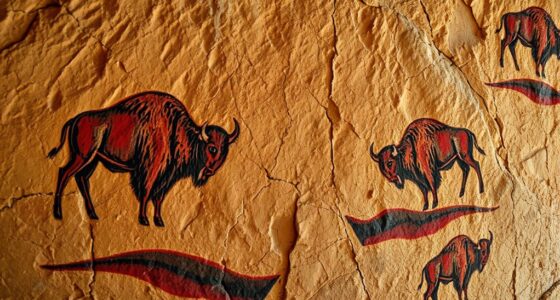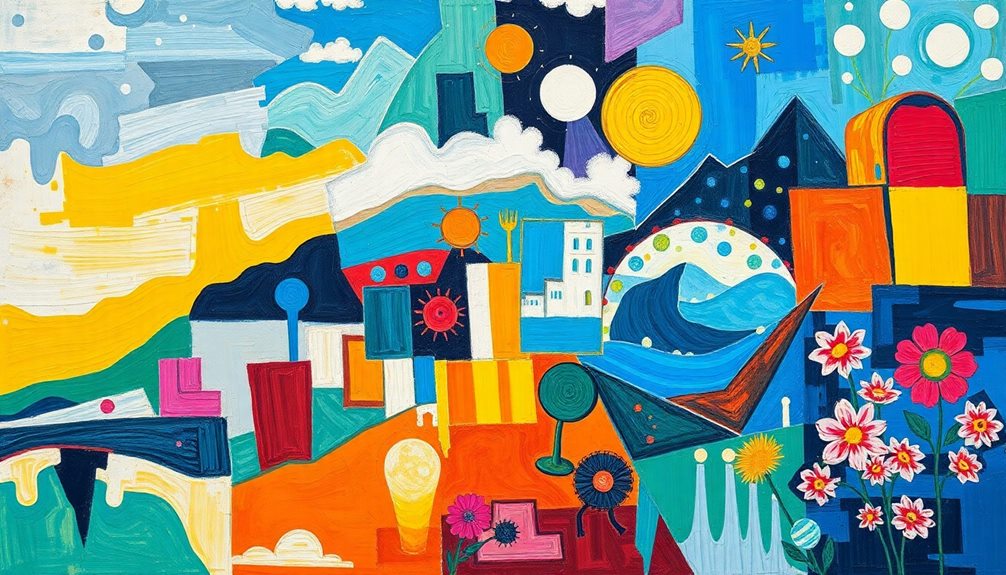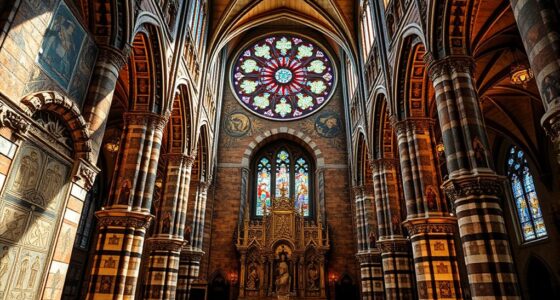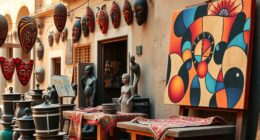The art of the Americas reflects vibrant indigenous traditions through masks, textiles, and carvings that embody spiritual beliefs and cultural identities. You’ll see masks representing spirits, ancestors, and gods, often used in rituals. Textiles tell stories and symbolize social bonds with intricate patterns and colors created through traditional techniques. These masterpieces preserve history, reinforce community values, and express worldviews rooted in harmony and storytelling. Explore further to uncover the rich symbolism behind these timeless creations.
Key Takeaways
- Indigenous art features ceremonial masks, textiles, and carvings that embody spiritual beliefs, ancestors, and cultural stories.
- Traditional textiles use intricate weaving, natural dyes, and symbolic motifs to convey social and spiritual meanings.
- Artistic objects serve as narratives, prayers, and identity markers, reflecting deep cultural symbolism and worldview.
- Techniques and motifs are transmitted through oral tradition and craft practices, often maintained by women and community elders.
- Pre-Columbian masterpieces reveal complex social structures, spiritual practices, and environmental knowledge integral to indigenous cultures.
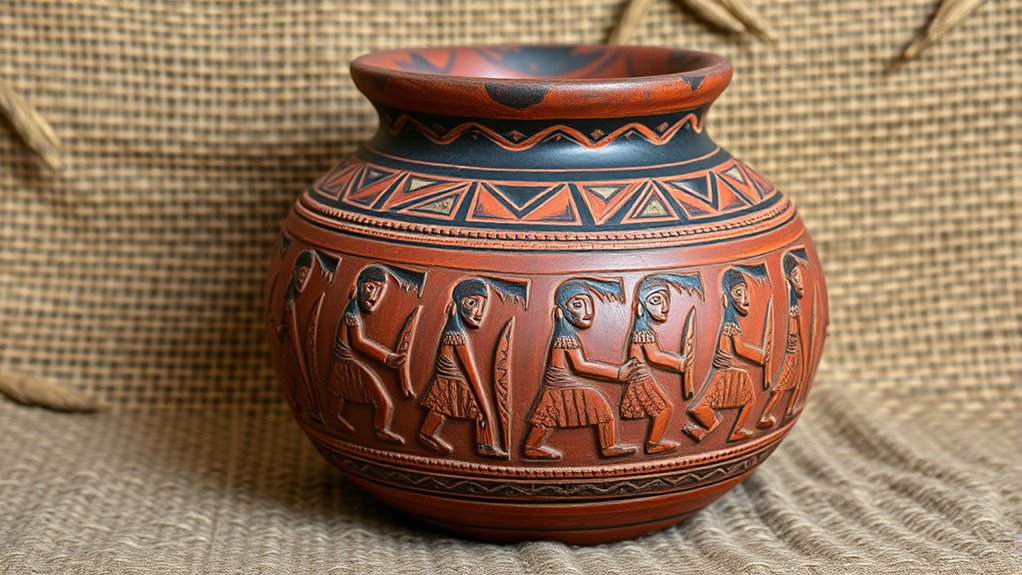
Have you ever wondered how the diverse cultures of the Americas have expressed their beliefs, histories, and identities through art? You’ll find that indigenous communities crafted intricate pieces that serve both spiritual and social purposes. For example, ceremonial masks are powerful symbols used in rituals, festivals, and rites of passage. These masks aren’t just decorative objects; they embody spirits, ancestors, or gods. Their designs often feature bold patterns, vibrant colors, and symbolic motifs that communicate stories and cultural values. When you examine these masks, you can sense the deep connection between art and spirituality, as well as the community’s desire to maintain tradition and honor their heritage.
Alongside masks, textile techniques play a crucial role in indigenous art across the Americas. You might notice that textiles aren’t merely functional clothing or decorative items—they’re woven with stories, symbols, and social significance. Many cultures, such as the Andean civilizations, developed complex weaving techniques that involved spinning, dyeing, and embroidery. These textiles often feature geometric patterns, animal motifs, or celestial symbols, reflecting their worldview. By studying these techniques, you gain insight into the skills, knowledge, and cultural exchanges that shaped these societies over generations. The use of natural dyes from plants and minerals highlights their deep understanding of their environment, turning simple fibers into vibrant works of art with spiritual and cultural meanings. Additionally, the transmission of these cultural techniques through generations demonstrates the importance of preserving heritage in indigenous communities. Recognizing that these techniques are often learned through oral tradition emphasizes the importance of storytelling in maintaining cultural identity.
You’ll also see that in many indigenous traditions, textile techniques are passed down through generations, maintaining a continuity that connects the present with the past. Women, in particular, often serve as keepers of these skills, and their work becomes a form of cultural preservation. The process of creating ceremonial masks and textiles involves meticulous craftsmanship, patience, and a profound understanding of symbolism. These objects are often used in rituals or ceremonies, reinforcing social bonds and spiritual beliefs. Recognizing how cultural symbolism is embedded in these objects can deepen your appreciation of their significance beyond aesthetic value. When you explore indigenous art of the Americas, you realize that these creative expressions are more than aesthetic—each piece is a narrative, a prayer, or a symbol of identity that sustains communities across time.
In essence, the art of the Americas reflects a complex interplay of spiritual beliefs, social structures, and environmental knowledge. Whether through the carved details of ceremonial masks or the intricate patterns of textiles, these works reveal a worldview rooted in harmony, tradition, and storytelling. As you explore these artistic traditions, you’ll see that they continue to influence contemporary indigenous practices, keeping alive the vibrant cultural legacy of the Americas.
Frequently Asked Questions
How Did Indigenous Art Influence Modern American Art Movements?
You see that indigenous symbolism has profoundly shaped modern American art movements. Artists incorporate traditional motifs and themes, blending them with contemporary styles through modern art integration. This fusion honors indigenous roots while creating fresh, meaningful expressions. By doing so, you help preserve cultural heritage and challenge mainstream narratives, fostering a richer, more diverse artistic landscape that celebrates indigenous influences in today’s art scene.
What Materials Were Most Commonly Used in Pre-Columbian Sculptures?
You’ll find that pre-Columbian sculptures mainly used stone carving and ceramic techniques. Artists often worked with materials like jade, basalt, and limestone, shaping durable stone for intricate carvings. They also crafted vessels and figures from clay using firing techniques that created strong ceramic pieces. These materials allowed them to produce lasting artworks that reflected their cultural beliefs and skills, showcasing their mastery in both stone and ceramic craftsmanship.
Are There Undiscovered Artifacts Still Hidden in Archaeological Sites?
Imagine archaeology as a treasure hunt, with hidden tombs and secret artifacts waiting to be uncovered. You might not realize, but many sites still hold undiscovered artifacts deep beneath the surface. These hidden tombs could contain priceless relics, offering new insights into ancient cultures. As explorers dig deeper, they continue to reveal mysteries, reminding you that history’s secrets often lie just beneath your feet, waiting to be found.
How Do Indigenous Art Techniques Vary Across Different American Regions?
You’ll notice that indigenous art techniques vary greatly across American regions. In Mesoamerica, pottery decoration often features intricate painted designs, while in the Andes, textile weaving showcases vibrant patterns and complex weaves. North American tribes might emphasize beadwork or carvings. These regional differences reflect local resources and cultural traditions, giving each area a unique artistic identity that highlights their distinct approaches to creative expression and craftsmanship.
What Are the Conservation Challenges for Preserving Ancient Artworks?
When you work on preserving ancient artworks, you face key challenges like environmental threats and restoration ethics. You must carefully balance cleaning and repair without damaging the original piece. Environmental threats, such as humidity, temperature changes, and pollution, accelerate deterioration. You need to implement proper conservation methods, respecting the artwork’s integrity, and follow ethical guidelines to make certain these treasures endure for future generations.
Conclusion
You’ve seen how indigenous traditions shaped stunning masterpieces across the Americas. Did you know that over 60% of pre-Columbian artifacts remain undiscovered, waiting to reveal more about these rich cultures? By exploring these ancient artworks, you gain a deeper appreciation for their enduring legacy and influence. Keep exploring, because each discovery helps preserve an essential part of history, connecting us to the vibrant traditions of the past.

